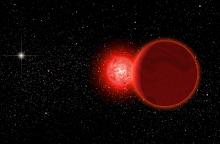Listen to today's episode of StarDate on the web the same day it airs in high-quality streaming audio without any extra ads or announcements. Choose a $8 one-month pass, or listen every day for a year for just $30.
You are here
Moon and Spica
Measuring the distances to the stars isn’t easy — even for the brightest stars of all. Consider Spica, the leading light of Virgo and the 16th-brightest star system in the night sky. It climbs into good view by 11 or 11:30. It rises below the Moon tonight, and closer to the upper right of the Moon tomorrow night.
Spica consists of two big, hot, bright stars. They’re so close together, though, that their light blurs into a single pinpoint.
The best estimate for the distance to Spica is 250 light-years, with a margin of 10 light-years either way. Astronomers came up with those numbers by measuring the system’s parallax — an apparent shift in its position.
Astronomers measure the direction of Spica six months apart, when Earth is on opposite sides of the Sun. That causes a tiny shift in Spica’s location against the background of more-distant stars. It’s like holding a pencil in front of you and looking at it with first one eye, then the other. As you blink back and forth, the pencil appears to move against the background. The size of that shift tells you the distance to the pencil.
For the stars, the angle is tiny. So it takes many observations with sharp instruments to get an accurate measurement. And the farther the star, the more difficult the task. So even though Spica is one of the brighter stars in the night sky, there’s still some wiggle room in its distance: roughly 250 light-years.
Script by Damond Benningfield






